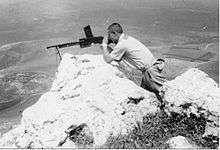FM 24/29 light machine gun
| FM 24/29 | |
|---|---|
|
LMG 24/29 | |
| Type | Light machine gun |
| Place of origin | France |
| Service history | |
| In service |
1925–1950s 1930s to 2000–2006 (National Gendarmerie) |
| Used by | See Users |
| Wars |
Rif War World War II First Indochina War Algerian War Suez Crisis Vietnam War Cambodian Civil War Western Sahara War |
| Production history | |
| Designer | Lt col. Reibel assisted by Chief Armorer Chosse |
| Designed | 1923 |
| Manufacturer | Manufacture d'Armes de Châtellerault |
| Produced | 1925-1957 (190,400 delivered) |
| Variants |
M1924-M29D M1931 |
| Specifications | |
| Weight | 8.9 kg (19.7 lb) |
| Length | 1080 mm (42.5 in) |
|
| |
| Cartridge | 7.5×54mm French |
| Caliber | 7.5mm |
| Barrels | 1 |
| Action | Gas-operated |
| Rate of fire | 450 rpm |
| Muzzle velocity | 830 m/s (2,722.4 ft/s) |
| Feed system | 25 round detachable box magazine |
| Sights | Iron sights |
The Fusil-mitrailleur Modèle 1924 M29 was the standard light machine gun of the French Army from 1925 until the 1960s and was in use until 2000-2006 with the National Gendarmerie. It fires the French 7.5×54mm round which is equivalent in ballistics and striking power to the later 7.62×51mm NATO (.308 Winchester) round. A robust and reliable weapon partly derived from the M1918 Browning Automatic Rifle (BAR) action, the FM 1924 M29 soldiered on, practically without interruptions, for more than 50 years.
Development
After the end of World War I, the French Army sought to replace the problematic Fusil-mitrailleur mle 1915 CSRG light machine rifle (better known as the Chauchat). French commanders considered standardizing on the American Browning Automatic Rifle (BAR), but eventually required the development of a locally built weapon. MAS (an abbreviation of Manufacture d'Armes de St. Etienne - one of several government-owned arms factories in France) proposed a direct derivative of the BAR, but the Manufacture d'Armes de Châtellerault (MAC) won the bid with its weapon, which was partly derived from the BAR action. It had been formulated and designed by a Lieutenant Colonel Reibel assisted by Chief Armorer Chosse.
The FM Mle 1924 entered production in late July 1925 and saw first operational use in Morocco in May 1926. It was immediately well-received and even favorably compared in performance with the much heavier Hotchkiss machine gun. However, problems created by the new 7.5mm ammunition did appear. In particular, 8×57mm Mauser ammunition which was used in captured Mauser rifles carried by auxiliaries in Morocco during the Rif War from 1920–26, could be chambered and fired with disastrous results. This situation led to the development of a slightly shorter 7.5×54mm round, which was retained in 1929 as the standard ammunition for all future rifles and light machine guns in French service. The modified fusil-mitrailleur modèle 1924 modifié 1929 (FM Mle 1924 M29) was mass-manufactured (187,412), beginning in 1930. In addition to these newly manufactured guns some 45,530 older FM Mle 1924s, already in service after phasing out the notoriously unreliable Chauchat, were rebarreled in order to accept the newer 7.5×54mm ammunition.
Both the original fusil-mitrailleur Mle 1924 (automatic rifle, model of 1924) as well as the modified Mle 1924 M29 have the same overall features: a folding bipod, an in-line stock, a pistol grip, a top-mounted 25-round detachable magazine and a bolt hold-open after the magazine's last round had been fired. There are two separate triggers: the trigger in front for using semi-automatic fire only and the rear trigger for firing on full automatic. Protection of all the openings against mud and dust proved excellent. The cyclic rate was controlled at 450 rounds per minute, thus allowing more continuous firing without overheating. In general, this new weapon was accurate and highly reliable but the barrel was screwed well into the receiver, as in the Browning Automatic Rifle (BAR), and thus it could not be separated quickly and easily in the field as for the British Bren gun. The French Army instruction manual (July 1925) recommends not to go beyond 400 rounds of uninterrupted firing since at that point the gun needs to be given a pause of ten to fifteen minutes in order to cool off. But instead, the French instruction manual recommends the following routine for the FM 1924 : fire 4 to 5 detachable magazines (100 to 125 rounds), take a short pause, then keep repeating that same restrained fire plus short pause routine which permits steady performance and very extensive firing periods.
Operational use

The FM 24/29 was the standard squad-level automatic weapon of the French infantry and cavalry at the start of World War II. After the French surrender in World War II, the Germans captured large quantities of this weapon, which they used operationally until the end of the war.
From 1943 on, as the French army was re-equipped and reorganized in North Africa with Allied support, the FM 24/29 was kept in service, as French troops considered it superior to the Browning Automatic Rifle.
The FM 24/29 was the workhorse in the First Indochina War and served in the armed forces until after the end of the war in Algeria. It was replaced by the AA-52 general-purpose machine gun in the 1960s, but it was still in use with National Gendarmerie regional brigades until 2000-2006.
Variants
Model 1924/1929D machine gun

The Model 1924/1929D machine gun was a variant of the MAC 24/29, adapted to firing from interior firing ports in the bunkers of the Maginot Line.[1]
M1931
A modified version of the gun, the M1931, with a heavier barrel and 150-round side-mounted pan magazine, was produced as a heavy machine gun for installation in tanks and fortified emplacements, particularly the Maginot Line. The heavier barrel allowed for more sustained fire before overheating, with the added mass acting as a heat sink. This was required because a weapon used in fixed emplacements must be able to deliver sustained fire, and without a quick-change barrel or water-cooling, a lighter barrel would rapidly overheat and wear out. The fact that it was no longer intended to be a portable weapon, as the FM24/29 was, meant that the added weight was of little consequence. In addition, a special twin-mounting was devised that allowed the users to fire each gun individually. This allowed the crew to switch between guns, using one while the second was cooling down. Both could be fired together in cases where a high rate of fire was required. When used singly, as in tanks and other vehicles, they were called the Modelle 1931; as a twin-mounting, they were known as the Reibel machine gun. The rate of fire of this version was raised to 600 rounds per minute per gun, although practical rate of fire was limited by the need for cooling rests and magazine changes. Production ran from 1931 to 1940.[2]
Users
 France: First adopted by French Army in 1924.[3] Also saw service with the National Gendarmerie.[4]
France: First adopted by French Army in 1924.[3] Also saw service with the National Gendarmerie.[4] Greece:
Greece: Israel: At least 200 were in service with the IDF, possibly more prior to the formation of the IDF. A 1942 dated field manual was written or translated by the Haganah. The gun was referred to as "מקלע צרפתי שטו," or "French machine gun château," probably a corruption of "Châtellerault," where the FM 24/29 was made.
Israel: At least 200 were in service with the IDF, possibly more prior to the formation of the IDF. A 1942 dated field manual was written or translated by the Haganah. The gun was referred to as "מקלע צרפתי שטו," or "French machine gun château," probably a corruption of "Châtellerault," where the FM 24/29 was made.

 Poland: Only the M1931 version on Hotchkiss H-39 and Renault R-35 tanks, acquired in 1939.[5]
Poland: Only the M1931 version on Hotchkiss H-39 and Renault R-35 tanks, acquired in 1939.[5].svg.png) Spain IFNI Western Sahara conflict
Spain IFNI Western Sahara conflict.svg.png) Germany: Captured weapons. The mle 1924/29 served as Leichtes MG 116(f); the 1931 model served as Kpfw MG 331(f).[6] The few surviving Mle 1924 models were given the designation Leichtes MG 115(f).[7] There was also a Fremdgerätenummer (foreign equipment number) for a Leichtes MG 107(f), with the original name given as "Fusil-mitrailleur «Lewis» mle 1924" chambered in either 8mm x 50R Lebel or in 6.5mm x 55 Mauser,[8][9] but this was French variant of the Lewis gun.[10]
Germany: Captured weapons. The mle 1924/29 served as Leichtes MG 116(f); the 1931 model served as Kpfw MG 331(f).[6] The few surviving Mle 1924 models were given the designation Leichtes MG 115(f).[7] There was also a Fremdgerätenummer (foreign equipment number) for a Leichtes MG 107(f), with the original name given as "Fusil-mitrailleur «Lewis» mle 1924" chambered in either 8mm x 50R Lebel or in 6.5mm x 55 Mauser,[8][9] but this was French variant of the Lewis gun.[10]-
 Niger[11]
Niger[11]  North Vietnam (Viet Cong)[12]
North Vietnam (Viet Cong)[12] Republic of China: Used by Yunnan clique which was the Army of Yunnan, China and fighting against the Japanese soldiers during the Second Sino-Japanese War.
Republic of China: Used by Yunnan clique which was the Army of Yunnan, China and fighting against the Japanese soldiers during the Second Sino-Japanese War.
See also
- ZB vz. 26
- Breda 30
- Bren light machine gun
- Charlton Automatic Rifle
- Mendoza C-1934
- Madsen machine gun
- Type 11 Light Machine Gun
- Type 99 light machine gun
- Degtyaryov machine gun
- Lahti-Saloranta M/26
References
- ↑ http://armesfrancaises.free.fr/FM%20Mle%2024-29%20(D).html
- ↑ http://world.guns.ru/machine/mg96-e.htm
- ↑ http://world.guns.ru/machine/fr/mac-m1924-e.html
- ↑ armesfrancaises.free.fr/FM Mle 24-29.html
- ↑ http://www.derela.republika.pl/weap.htm
- ↑ Chris Bishop (2002). The Encyclopedia of Weapons of World War II. Sterling Publishing Company, Inc. p. 241. ISBN 978-1-58663-762-0.
- ↑ Peter Chamberlain; Terry Gander (1974). Machine guns. Arco Pub. Co. p. 15. ISBN 978-0-668-03608-5.
- ↑ img246.imageshack.us/img246/1087/lewis24.jpg
- ↑ forums.gunboards.com/showthread.php?209355-Lewis-automatic-rifle
- ↑ Machine guns, World War II fact files by Peter Chamberlain, Terry Gander Arco Pub. Co., 1974, ISBN 0668036087, pp. 44-45
- ↑ https://sites.google.com/site/worldinventory/wiw_af_niger
- ↑ Chris Bishop (1996). Vital Guide to Combat Guns and Infantry Weapons. p. 203. ISBN 1853105392.
Bibliography
- Ferrard, Stéphane. France 1940 l'armement terrestre, ETAI, 1998, ISBN 978-2-7268-8380-8
- Philippe Truttman, La Muraille de France ou la Ligne Maginot, Gérard Klopp éditeur, 1985.
- Claude Lombard, La Manufacture Nationale d'Armes de Chatellerault, 1987, Editor : Brissaud,162 Grande Rue, Chatellerault. A technical history of all the military firearms developed and manufactured at Chatellerault . This volume includes a highly detailed technical chapter dealing with the FM Mle 1924 and Mle 1924-M29. ISBN 2-902170-55-6 ( in French ).
- "Instruction Provisoire de Juillet 1925 sur le Fusil-Mitrailleur 1924", Charles-Lavauzelle & Cie, Paris, 1928.